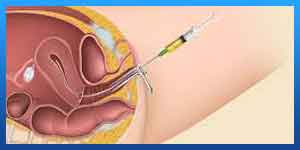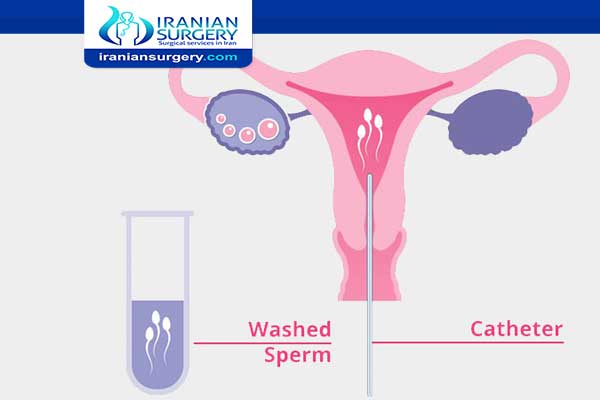Intrauterine Insemination (IUI)
IUI Timeline
What is Intrauterine Insemination (IUI)?
Intrauterine insemination (IUI) — a type of artificial insemination — is a procedure for treating infertility.
Sperm that have been washed and concentrated are placed directly in your uterus around the time your ovary releases one or more eggs to be fertilized.
The hoped-for outcome of intrauterine insemination is for the sperm to swim into the fallopian tube and fertilize a waiting egg, resulting in a normal pregnancy. Depending on the reasons for infertility, IUI can be coordinated with your normal cycle or with fertility medications.
Read more about : Surrogacy in Iran
Read more about : What is Preimplantation Genetic Diagnosis (PGD)?
Read more about : Ivf process timeline
Read more about : Icsi procedure step by step
Read more about : What are the Biggest Differences between IUI and IVF?
Before Intrauterine Insemination (IUI)
Why it's done
A couple's ability to become pregnant depends on many different factors. Intrauterine insemination is used most often in couples who have:
. Donor sperm. For women who need to use donor sperm to get pregnant, IUI is most commonly used to achieve pregnancy. Frozen donor sperm specimens are obtained from certified labs and thawed before the IUI procedure.
. Unexplained infertility. IUI is often performed as a first treatment for unexplained infertility along with ovulation-inducing medications.
. Endometriosis-related infertility. For infertility related to endometriosis, using medications to obtain a good-quality egg along with performing IUI is often the first treatment approach.
. Mild male factor infertility (subfertility). Your partner's semen analysis, one of the first steps in the medical assessment of infertility, may show below-average sperm concentration, weak movement (motility) of sperm, or abnormalities in sperm size and shape (morphology). IUI can overcome some of these problems because preparing sperm for the procedure helps separate highly motile, normal sperm from those of lower quality.
. Cervical factor infertility. Your cervix, at the lower end of the uterus, provides the opening between your vagina and uterus. Mucus produced by the cervix around the time of ovulation provides an ideal environment for sperm to travel from your vagina to the fallopian tubes. But, if your cervical mucus is too thick, it may impede the sperm's journey. The cervix itself may also prevent sperm from reaching the egg. Scarring, such as that caused by a biopsy or other procedures, can cause the cervix to thicken. IUI bypasses your cervix, depositing sperm directly into your uterus and increasing the number of sperm available to meet the awaiting egg.
Read more about : Cervical cancer
. Ovulatory factor infertility. IUI may also be performed for women who have infertility caused by problems with ovulation, including an absence of ovulation or a reduced number of eggs.
. Semen allergy. Rarely, a woman could have an allergy to proteins in her partner's semen. Ejaculation into the vagina causes redness, burning and swelling where the semen contacts the skin. A condom can protect you from the symptoms, but it also prevents pregnancy. If your sensitivity is severe, IUI can be effective, since many of the proteins in semen are removed before the sperm is inserted.
IUI isn’t effective in the following scenarios:
. Women with moderate to severe endometriosis
. Women who have had both fallopian tubes removed or have both fallopian tubes blocked.
. Women with severe fallopian tube disease
. Women who have had multiple pelvic infections
. Men who produce no sperm (unless the couple wishes to use donor sperm)
In situations where IUI isn’t recommended, another treatment such as IVF may be helpful. If you wish to discuss options for conceiving, your doctor can help determine the best course for you.

Read more about : ZIFT infertility treatment
Risks
Intrauterine insemination is a relatively simple and safe procedure, and the risk of serious complications is low. Risks include:
. Infection. There's a slight risk of developing an infection as a result of the procedure.
. Spotting. Sometimes the process of placing the catheter in the uterus causes a small amount of vaginal bleeding. This doesn't usually have an effect on the chance of pregnancy.
. Multiple pregnancy. IUI itself isn't associated with an increased risk of a multiple pregnancy — twins, triplets or more. But, when coordinated with ovulation-inducing medications, the risk of a multiple pregnancy increases significantly. A multiple pregnancy has higher risks than a single pregnancy does, including early labor and low birth weight.
. Ovarian hyperstimulation syndrome. Sometimes the ovaries over-respond to fertility medications (particularly the medications given as injections) and a condition called ovarian hyperstimulation syndrome may result. A large number of eggs may be matured at one time and possibly released. This can result in an enlarged ovary, fluid buildup in the abdomen, and cramping. In very rare cases, ovarian hyperstimulation syndrome can result in fluid buildup in the chest and abdomen, kidney problems, blood clots, and twisting of the ovary.
If you’re currently taking fertility medications for IUI and experience any of the following symptoms, you should call your doctor immediately.
. Dizziness or lightheadedness
. Sudden weight gain of more than 5 pounds
. Shortness of breath
. Nausea and vomiting
. Severe abdominal or pelvic pain
. Sudden increase in abdominal size
Read more about : Can i bend down after embryo transfer?
How you prepare
Intrauterine insemination involves careful coordination before the actual procedure:
. Preparing the semen sample. Your partner provides a semen sample at the doctor's office, or a vial of frozen donor sperm can be thawed and prepared. Because nonsperm elements in semen can cause reactions in the woman's body that interfere with fertilization, the sample will be washed in a way that separates the highly active, normal sperm from lower quality sperm and other elements. The likelihood of achieving pregnancy increases by using a small, highly concentrated sample of healthy sperm.
. Monitoring for ovulation. Because the timing of IUI is crucial, monitoring for signs of impending ovulation is critical. To do this, you might use an at-home urine ovulation predictor kit that detects when your body produces a surge or release of luteinizing hormone (LH). Or, an imaging method that lets your doctor visualize your ovaries and egg growth (transvaginal ultrasound) can be done. You also may be given an injection of human chorionic gonadotropin (HCG) or medications to make you ovulate one or more eggs at the right time.
. Determining optimal timing. Most IUIs are done a day or two after detecting ovulation. Your doctor or other care provider will have a plan spelled out for the timing of your procedure and what to expect.
During Intrauterine Insemination (IUI)
During the procedure
The visit for intrauterine insemination takes about 15 to 20 minutes and is usually done in a doctor's office or clinic. The IUI procedure itself takes just a minute or two and requires no medications or pain relievers. Your doctor or a specially trained nurse performs the procedure.
While lying on an exam table, you'll put your legs into stirrups and a speculum will be inserted into your vagina — similar to what you experience during a Pap test. During the procedure, the doctor or nurse:
. Attaches a vial containing a sample of healthy sperm to the end of a long, thin, flexible tube (catheter).
. Inserts the catheter into your vagina, through your cervical opening and into your uterus.
. Pushes the sperm sample through the tube into your uterus
. Removes the catheter, followed by the speculum
After Intrauterine Insemination (IUI)
After the procedure
After insemination, you'll be asked to lie on your back for a brief period. Once the procedure is over, you can get dressed and go about your normal daily activities. You may experience some light spotting for a day or two after the procedure.
Results
Wait two weeks before taking an at-home pregnancy test. Testing too soon could produce a result that is:
. False-negative. If pregnancy hormones aren't yet at measurable levels, the test result may be negative when, in fact, you really are pregnant.
. False-positive. If you're using ovulation-inducing medication such as HCG, the medication that's still circulating in your body could indicate a pregnancy when you really aren't pregnant.
Your doctor may instruct you to return about two weeks after your home kit results for a blood test, which is more sensitive in detecting pregnancy hormones after fertilization.
If you don't become pregnant, you might try IUI again before moving on to other fertility treatments. Often, the same therapy is used for three to six months to maximize chances of pregnancy.
What’s the success rate like?
Every couple will have a different response to IUI, and it can be difficult to predict its success. A number of factors affect the outcome, including:
Read more about : Can you have twins with ICSI?
. Age
. Underlying infertility diagnosis
. Whether fertility drugs are used
. Other underlying fertility concerns
Pregnancy rates following IUI are varied based on your reasons for needing fertility treatment. Success rates for IUI tend to decrease in women over the age of 40, and in women who have not gotten pregnant after three cycles of IUI. You should discuss your predicted success rate with your fertility specialist to see if this a good option for you.



1 Comment
Hi,
Wow, a Very Nice blog post! Your site has given the best information From Your Articles. They are amazing and Useful to all people. Thank you for sharing this post and Impressive site. The IVF advanced is one of the most excellent centers in Asia Pacific, with Techniques, genuine Treatment, Research & Training. The IVF advanced is the leading Test Tube Centre in the country with modern world-class scientific technologies.